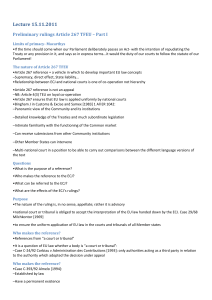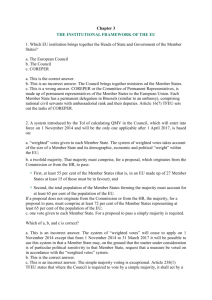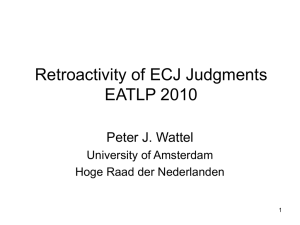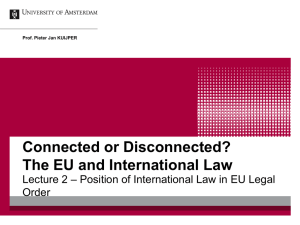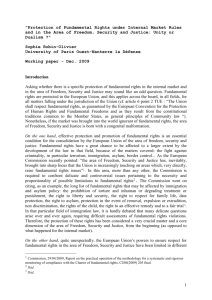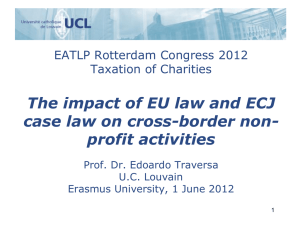Preliminary Ruling on Interpretation
advertisement
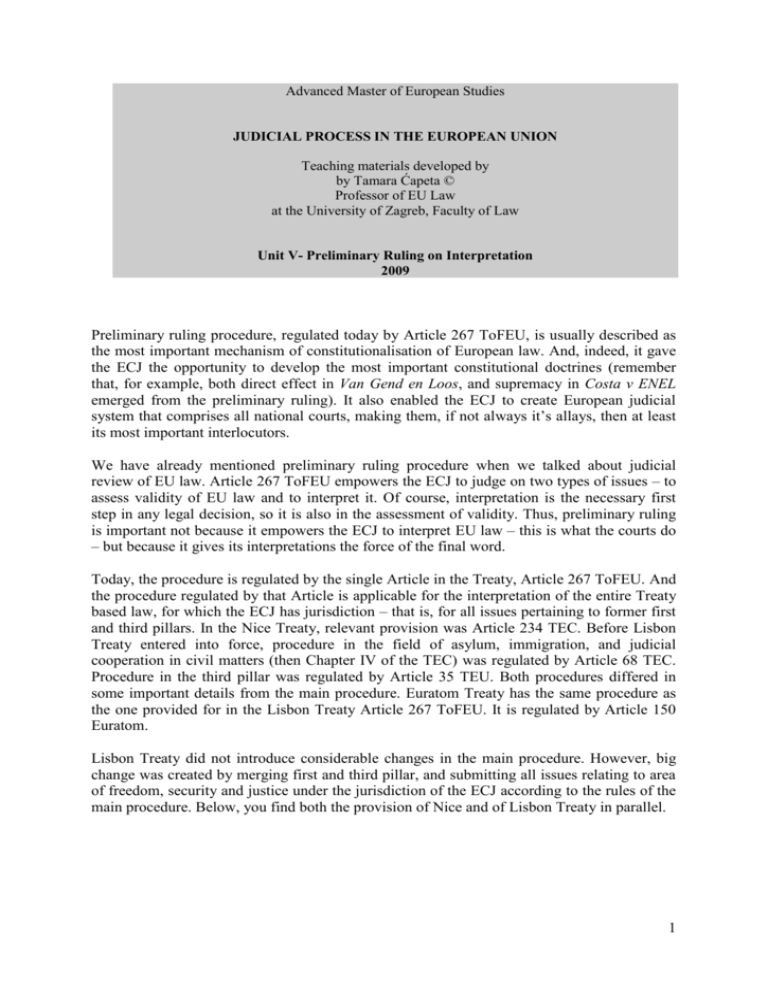
Advanced Master of European Studies JUDICIAL PROCESS IN THE EUROPEAN UNION Teaching materials developed by by Tamara Ćapeta © Professor of EU Law at the University of Zagreb, Faculty of Law Unit V- Preliminary Ruling on Interpretation 2009 Preliminary ruling procedure, regulated today by Article 267 ToFEU, is usually described as the most important mechanism of constitutionalisation of European law. And, indeed, it gave the ECJ the opportunity to develop the most important constitutional doctrines (remember that, for example, both direct effect in Van Gend en Loos, and supremacy in Costa v ENEL emerged from the preliminary ruling). It also enabled the ECJ to create European judicial system that comprises all national courts, making them, if not always it’s allays, then at least its most important interlocutors. We have already mentioned preliminary ruling procedure when we talked about judicial review of EU law. Article 267 ToFEU empowers the ECJ to judge on two types of issues – to assess validity of EU law and to interpret it. Of course, interpretation is the necessary first step in any legal decision, so it is also in the assessment of validity. Thus, preliminary ruling is important not because it empowers the ECJ to interpret EU law – this is what the courts do – but because it gives its interpretations the force of the final word. Today, the procedure is regulated by the single Article in the Treaty, Article 267 ToFEU. And the procedure regulated by that Article is applicable for the interpretation of the entire Treaty based law, for which the ECJ has jurisdiction – that is, for all issues pertaining to former first and third pillars. In the Nice Treaty, relevant provision was Article 234 TEC. Before Lisbon Treaty entered into force, procedure in the field of asylum, immigration, and judicial cooperation in civil matters (then Chapter IV of the TEC) was regulated by Article 68 TEC. Procedure in the third pillar was regulated by Article 35 TEU. Both procedures differed in some important details from the main procedure. Euratom Treaty has the same procedure as the one provided for in the Lisbon Treaty Article 267 ToFEU. It is regulated by Article 150 Euratom. Lisbon Treaty did not introduce considerable changes in the main procedure. However, big change was created by merging first and third pillar, and submitting all issues relating to area of freedom, security and justice under the jurisdiction of the ECJ according to the rules of the main procedure. Below, you find both the provision of Nice and of Lisbon Treaty in parallel. 1 Nice Treaty - Article 234 TEC (ex 177) Lisbon Treaty - Article 267 ToFEU The Court of Justice shall have jurisdiction to give preliminary rulings concerning: (a) the interpretation of this Treaty; (b) the validity and interpretation of acts of the institutions of the Community and of the ECB; (c) the interpretation of the statutes of bodies established by an act of the Council, where those statutes so provide. The Court of Justice of the European Union shall have jurisdiction to give preliminary rulings concerning: (a) the interpretation of the Treaties; (b) the validity and interpretation of acts of the institutions, bodies, offices or agencies of the Union; Where such a question is raised before any court or tribunal of a Member State, that court or tribunal may, if it considers that a decision on the question is necessary to enable it to give judgment, request the Court of Justice to give a ruling thereon. Where such a question is raised before any court or tribunal of a Member State, that court or tribunal may, if it considers that a decision on the question is necessary to enable it to give judgment, request the Court to give a ruling thereon. Where any such question is raised in a case pending before a court or tribunal of a Member State against whose decisions there is no judicial remedy under national law, that court or tribunal shall bring the matter before the Court of Justice. Where any such question is raised in a case pending before a court or tribunal of a Member State against whose decisions there is no judicial remedy under national law, that court or tribunal shall bring the matter before the Court. If such a question is raised in a case pending before a court or tribunal of a Member State with regard to a person in custody, the Court of Justice of the European Union shall act with the minimum of delay. As preparation for the class, read the chapter on preliminary ruling from a textbook of your choice. We shall not deal with every aspect of procedure in the class. Preliminary ruling procedure is based on the cooperation between the ECJ and national courts. What I shall try to show is how has the procedure changed, and how this has affected the relationship between two most important actors – ECJ and national courts. We shall try to figure out possible reasons for this, including the question of whether this was justified or should be criticized. Jurisdiction to answer preliminary requests (either on interpretation or on validity) is exclusively in the hands of the ECJ. However, since the Nice Treaty (and taken over into the Lisbon Treaty – Article 256/3 ToFEU), it is provided that this jurisdiction may in some areas also be devolved to the Court of First Instance/General Court. This is to be provided for in the Statute, which may be amended in accordance with the ordinary legislative procedure (EP and Council acting together). The proposal may come either from the ECJ or from the Commission, the other institution being consulted. For now, the ECJ is not prepared to give up part of its preliminary ruling jurisdiction, as this might prove damaging for the uniformity of EU law. 2 Purpose of Preliminary Ruling on Interpretation The main purpose of the preliminary ruling procedure is to ensure the uniform application of Community law. Think about how is the uniform application of law guaranteed within the domestic judicial systems? Because judicial construction of law is not only the task of the Court but is a discursive exercise, the Treaty (in Statute of the ECJ, Art. 23) allowed for large number of participants in the preliminary ruling. Thus, parties to the domestic dispute, all Member States, as well as Commission are invited to give their opinions to the Court as to the proper construction of the EU rule in question. Additionally, if the act originates from the Council, European Parliament, or the ECB they may as well intervene in the case. The possibility of participation of many different interests in constructing the meaning of EU law legitimizes the ‘final word’ status of the preliminary rulings given by the Court. Very often the reason why Member States’ courts seek preliminary ruling from the Court is to enable them to decide about non-application of a rule of national law. Thus, preliminary ruling plays an important role in facilitating judicial review of national law for its conformity with EU law. Initiator of Preliminary Ruling Procedure The preliminary ruling procedure is put in motion exclusively by national courts. It is, therefore, important to know what is meant by that expression (the Treaty expression in English version is 'court or tribunal of a Member State'). The ECJ explained that the concept of ‘court or tribunal’ is an EU law concept. It, therefore, falls on the ECJ to explain its meaning. The ECJ has never given complete definition of that expression, but rather stated some elements which an institution has to fulfil in order to be deemed a ‘court or tribunal’. Thus, the institution has to be established by law, apply rules of law in deciding, end up proceedings with binding decisions of definitive character, be established as lasting, conduct procedure inter partes, be independent, its jurisdiction must be compulsory (that is does not depend on the acceptance of the parties)... ‘Court or tribunal’ can also be an institution common to more Member States, as is, e.g. Benelux Court. An institution can sometimes lack some of the enumerated elements, especially inter partes procedure requirement, and still be considered a ‘court or tribunal’. In any case, as the concept of the court is not national, but rather European, some institutions that are not considered courts under national law might still be in position to require preliminary ruling from the ECJ, and vice-versa, some institutions understood as courts under national legal system, might not be courts for the purpose of preliminary ruling. In your materials you will find the Opinion of Advocate General Colomer in case C-17/00 De Coster, in which he gives the overview and critique of the ECJ's case law on this issue. It is offered as optional reading as you are not required to read it as part of preparation for class. Do, however, read it when preparing for the exam. Think about which bodies in your country could be deemed to be 'court or tribunal' in the sense of Article 267 ToFEU. Why is it important what is 'court or tribunal' from the ECJ's point of view? Why is it important from the point of view of domestic institutions? The national 'courts or tribunals' have either discretion or obligation to refer to the ECJ for the interpretation of EU law. Compare in this respect paragraphs 2 and 3 of the Article 267 3 ToFEU (this part of the provision was not changed by the Lisbon treaty). Many issues relating to both discretion and the duty were clarified in the case law. Therefore, in order to help national courts, the ECJ has prepared the Note addressed to them. Read the Note. Discretion to refer and jurisdiction of the ECJ Discretion to refer comprises the decision on whether to refer and when in the course of domestic proceedings to refer. This does not mean that every reference from the national court automatically establishes jurisdiction of the ECJ. There are occasions in which the ECJ would not consider itself to have jurisdiction to answer the question posed by national court. Read again Article 267 ToFEU and find in its text reasons for the ECJ to decline jurisdiction to decide on question posed by national court. Question has to concern interpretation of the 'Treaties' or 'acts of the institutions, bodies, offices or agencies of the Union’ ‘Treaties’ to which provision refers are Treaty on the European Union and ToFEU. The ECJ has jurisdiction to interpret all provisions of the Treaties except those relating to the CFSP (Article 275 ToFEU). Nice Treaty version of the preliminary ruling provision mentioned only EU institutions and the ECB as bodies whose acts could be object of the ruling on interpretation. Lisbon Treaty enlarged jurisdiction of the Court also to the acts of any other body, office or agency that is established under EU law. Decisions adopted under the CFSP powers cannot, however, be interpreted by the ECJ. The Court’s jurisdiction in that respect is expressly excluded by already mentioned Article 275 ToFEU. Even though the Treaty does not expressly mention international agreements signed by the EU, the ECJ has found to have jurisdiction for their interpretation, treating them as the acts of the institutions (case 181/73 Haegeman). It has likewise found itself competent to interpret acts adopted on the basis of such international agreements (case 129/89 Sevince), as well as agreements to which EU succeeded in the place or parallel to Member States, such as GATT (joined cases 267-268 SPI). Even if the argumentation offered by the ECJ was criticized (see Hartley), the ECJ’s jurisdiction to interpret international agreements to which EU is a party is not today disputed. The case law has also made it clear that an act of the institutions need not have direct effect (case 111/75 Mazalai) nor be legally binding (case C-322/88 Grimaldi) in order to trigger ECJ’s interpretative jurisdiction. There is one disputed situation in which the ECJ has considered itself to have jurisdiction, but this was opposed by several of its Advocate Generals and some scholars. There are situations in which internal laws of Member States adopt EU law solutions even for purely internal situations. When internal law was explicitly or implicitly relying on EU rule, the ECJ considered itself competent under Article 234 TEC (today 267 ToFEU) to give interpretation of such EU rule. Read the case Dzodzi and the Opinion of AG Darmon. Who, according to you is right? Why? Except for the peculiar situation in Dzodzi line of cases, the question cannot concern interpretation of domestic law. The national courts often need preliminary ruling in order to decide whether the provision of domestic law is conform or contrary to Community rule. Therefore, they often formulate questions to the ECJ in those terms: Is the provision of the 4 Italian law X contrary to Article C of Directive Y? The ECJ will not necessarily decline jurisdiction in such cases. It may reformulate the question, so as to extract the relevant issues of interpretation of EU law. The reformulated question would be something like: What is the proper meaning of Article C of Directive Y when it has to be applied to a situation as the one in the case in front of national court? Also, the ECJ can expand the question of national court to issues of EU law that the national court has not mentioned (Case 35/85 Tissier). Question has to concern 'interpretation', not the ‘application’ of EU law. What is the dividing line between interpretation and application? Read the answer (operative part of the judgment) given to national court in the case C-144/04 Mangold : “On those grounds, the Court (Grand Chamber) hereby rules: 1. On a proper construction of Clause 8(3) of the Framework Agreement on fixed-term contracts concluded on 18 March 1999, put into effect by Council Directive 1999/70/EC of 28 June 1999 concerning the framework agreement on fixed-term work concluded by ETUC, UNICE and CEEP, domestic legislation such as that at issue in the main proceedings, which for reasons connected with the need to encourage employment and irrespective of the implementation of that agreement, has lowered the age above which fixed-term contracts of employment may be concluded without restrictions, is not contrary to that provision. 2. Community law and, more particularly, Article 6(1) of Council Directive 2000/78/EC of 27 November 2000 establishing a general framework for equal treatment in employment and occupation must be interpreted as precluding a provision of domestic law such as that at issue in the main proceedings which authorises, without restriction, unless there is a close connection with an earlier contract of employment of indefinite duration concluded with the same employer, the conclusion of fixed-term contracts of employment once the worker has reached the age of 52. It is the responsibility of the national court to guarantee the full effectiveness of the general principle of non-discrimination in respect of age, setting aside any provision of national law which may conflict with Community law, even where the period prescribed for transposition of that directive has not yet expired.” Has the ECJ interpreted or applied EC law in that case? Do you consider such practice of giving very concrete answers to the national courts good or bad, and why? 'Where such a question is raised…' Who has to raise the question: Parties; national Court? Can national rules on the procedure and organisation of judicial system prevent national court from raising the issue? Read in this respect case 166/73 Rheinmühlen. Think about the consequences of the Court’s ruling on the relations within the internal judicial hierarchy. Who wins? Think about the application of Rheinmühlen in your country. In two cases – joined cases C-430-431/93 Van Schijndel and case C-312/93 Peterbroeck, the ECJ has confirmed that national procedural rules cannot stand in the way to efficiency of preliminary ruling procedure, unless they may be justified by legitimate reasons acceptable to both national and European legal order. The rule that seems to have emerged from these cases is that the national court has to rise issues of EU law on its own motion, and then, if necessary pass them to the ECJ, if national law obliges it to rise issues of domestic law ex officio, or if it only empowers the court to do so. On the other hand, if rising legal issues of its own motion is prohibited by domestic law, the judge need not raise the issue of EU law either, provided that 5 the rule preventing judge from such behaviour can be justified by reasons acceptable also from the point of view of European law. What does described case law mean for the courts in the countries in which the principle iura novit curia is literally understood? '…that court or tribunal may…' The preliminary ruling should help the judge who decides the case to solve the case. Therefore, the judge can only ask for the interpretation in her own name, and not for the benefit of some other proceedings or for general interest. That means that only the judge in front of who the case is still pending can ask the question. If she has concluded the case, without the possibility of its reopening in front of that same judge, even if an appeal is possible, but it lies in front of another judge, the ECJ will decline jurisdiction to answer the question (case 338/85 Pardini). '…if it considers that a decision on the question is necessary to enable it to give judgment…' The important issue here is who decides whether the answer is necessary? Read the Treaty provision again. What would you conclude? Now read the case Foglia v Novello II. What was the ECJ's opinion on who decides on the necessity of answer to the question? How has the Court described purpose of preliminary ruling procedure? The Court’s control over the issue whether the answer to the question posed by national court is necessary became in the eighties and especially in the nineties more tight. Except for the situations when it declined jurisdiction because the question asked was not, according to the ECJ's opinion, relevant for the resolution of the dispute (for example, C-343/90 Laurenco Dias) or was hypothetical (for example, C-83/91 Meilicke), the ECJ started to decline jurisdiction because the national court did not submit to it enough information on factual and internal legal context of the case (for example, C-307/95 Max Mara). This, according to the ECJ, disables it to check whether the issue of EU law is at all relevant for the dispute in front of the national court, and it does not allow it to give useful answer to the court. What are possible motives of the Court for tightening the control over the national courts’ questions? Are they justified? Do you see any problems with this? How could the Court's attitude towards the issue who decides about the necessity of the question influenced the relationship between ECJ and national courts? Duty to refer According to third paragraph of Article 267 ToFEU, the courts of last instance cannot choose whether to refer a question to the ECJ, if the answer to it is necessary to solve the dispute. They must refer. Whether a court is the court of last instance is judged in every particular case. Thus, for example, in Costa v ENEL, the ECJ considered the Giudice conciliatore to be the court of last instance in the sense of paragraph 3. Giudice was judge against whose decisions an appeal 6 usually lies. However, in the case in question this was not so, as it involved a very small amount of money. Find the relevant paragraph in the judgment. However, even if there is a relevant issue of Community law, there are two situations which relieve the court of last resort of the duty to refer. Read the case CILFIT and identify these two situations. The acceptance of the so called acte claire doctrine in CILFIT was, according to commentators, a reaction of the Court to the already existing practice of Member States’ highest courts to avoid sending references to the ECJ. However, the opinions of scholars about the aims that the ECJ wanted to accomplish in CILFIT and about its outcomes differ. Read the overview of different opinions in Craig/De Burca, pp. 446-449, (or even better, read articles mentioned there), and be prepared to discuss the issue in the class. Note that acte claire doctrine applies only to preliminary ruling on interpretation, not on validity. If there is a possibility that an EU act is invalid, the ECJ has, since the case 314/85 Foto-Frost, the exclusive jurisdiction to declare such invalidity. Therefore, all national courts have the obligation to refer, which does not disappear if it is obvious that EU act is invalid (see in that respect case C-461/03 Gaston Schul). Effects of preliminary rulings on interpretation In CILFIT (paragraph 13), the ECJ repeated a statement from an early decision in the case 2830/62 Da Costa. Read that paragraph of the judgment. What can you conclude about the effects of the preliminary rulings? Who do they bind? Only the national court which referred the question; other national courts; someone else? If Da Costa established a system in which the ECJ's interpretations bind all national courts, a system thus similar to the systems based on precedent, how would you interpret the finding of the Court that, notwithstanding the previous ruling, the national court can nevertheless repeat the question? If the previous interpretation is binding, can the repeated question pass the hurdle that it has to be 'necessary'? If the previous ruling is binding, what could be the justified reason for the national court to ask the ECJ same question again? Reading case Da Costa might help in finding an answer to that question. It is on your optional reading list. Having in mind that courts of lower instances enjoy discretion whether to refer the question and therefore also the possibility to interpret Community rules themselves, can such courts interpret Community law differently from the previous ruling of the ECJ? Can you think of justifications for the erga omnes effects of Court's interpretation? What can be the policy reasons justifying such a choice? The ECJ has offered some legal justifications in joined cases Salumi that was relevant for the question of temporal effects of preliminary rulings. Read the case and identify the justification offered by the ECJ. What about the effects in time? Do the interpretations bind the courts pro futuro or do they have retroactive effect? How can you justify this? In the case 43/75 Defrenne II, the ECJ has for the first time limited the effects of its judgment only to the pending and future cases. This was justified by financial concerns. What does such a choice tells us about the previously discussed issue on who do the preliminary rulings bind? 7 Craig and De Burca said that making preliminary rulings generally binding changed the bilateral relationship between the ECJ and national courts into multilateral one. Explain. Having in mind other constitutional doctrines, especially direct effect, did the ECJ really have any other choice? Urgent Preliminary Ruling Procedure Even though the ECJ is performing better year after year, the preliminary ruling procedure lasts for long time. According to statistics, in 2008, it lasted on average 16 months. This is only a fragment of the procedure that is taking place in the national court. There are situations, in which it is unacceptable for a person in front of the court to wait that long. Take, for example, someone imprisoned, or a kid in the middle of a dispute on custodial rights. With the introduction of the EU power in criminal judicial co-operation, this problem became even more accentuated. For that reason, the ECJ proposed the introduction of the Urgent preliminary ruling procedure (so called PPU – from French procédure préliminaire d’urgence). This procedure (regulated by Article 23a of the Statute of the Court and Article 104b of its Rules of Procedure) applies only in cases under the third pillar and those within the Chapter IV TEC (Nice) - visas, asylum, immigration issues, and judicial cooperation in civil matters. It applies in matters of real urgency and allows for much shorter decisionmaking by the Court. This is achieved through assigning the task of required interpretation to a chamber designated only for urgent procedures, through omitting certain stages in the procedure, shortening of time limits, and through omitting part of the translation that is performed in the regular procedure. Procedure should not last for longer than 2 months, and up to today three decided cases respected that limit. Read the Note prepared by the ECJ on PPU. Lisbon Treaty (new, fourth paragraph of Article 267 ToFEU) requires that urgency is afforded also to any case that relates to a person in custody, notwithstanding which part of EU law requires interpretation for the case to be solved. How will this be organized, or better, how will the new PPU be reorganized to satisfy Lisbon Treaty requirements remains to be seen. On the one hand, the PPU introduced under Nice is wider, as it covers more situations in which national court may require urgency, and on the hand, it is narrower, as it limits the possibility to require urgency in only some areas of EU law. Future of the Preliminary ruling procedure As the EU legal system has today constitutionally matured, the question arises should not something be modified in the judicial structure in the EU. Among other proposals, there is one about creating the appellate legal system, making the ECJ appellate court on questions of EU law. What do you think about this proposal? Would it solve the big problem of today’s preliminary rulings that considerably prolong the time till the solution of the dispute? Would it relieve the workload of the ECJ? How would you transform the EU judiciary? Others proposed that the ECJ is given power to control its own docket. Do you find this a good solution for the preliminary ruling? Likewise, today, there are no dissenting opinions in the ECJ? Should they be allowed? How would this influence the preliminary ruling procedure? Would it breach its purpose of assuring uniform application of EU law? 8 The Lisbon Treaty has not introduced any substantive changes into the preliminary ruling procedure. Thus, it should not be expected that the ECJ’s jurisdiction and its relationship with national courts will change in the close future. 9
